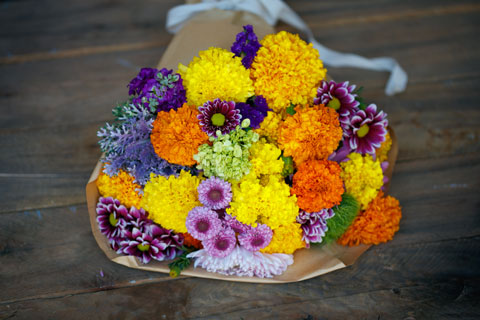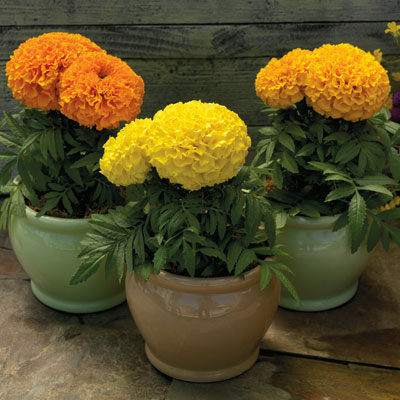1/1/2025
Marigolds: A Versatile Option for Multiple Seasons
Michael Wiebe

While marigolds hold fame among a loyal audience for certain holidays in various times of the year, they’ve seen a recent surge in popularity as decorations for late summer all the way through late fall and are a quintessential feature of traditional holidays in October and November. Known for their vibrant hues of orange, yellow and gold, marigolds perfectly embody the warmth and richness of the season.
While cut marigolds have long been cherished for festive arrangements, the trend of using potted marigold plants as decorative accents has grown significantly. These versatile plants add a bold, seasonal charm to landscapes, porches, tables and centerpieces. Their association with cultural celebrations, such as Día de los Muertos, further enhances their appeal, solidifying marigolds as a staple in autumn decor.
Such a swell in popularity may have also come from the recognition of consumers to the profuse blooms that marigolds offer as the summer season exits and the fall season arrives. African marigolds are facultative short-day plants, and as such, will bloom more readily under fall short-day conditions, thus offering more blooms per plant than perhaps under hot, long-day summer conditions.
Here, we’ll highlight the attributes and cultural practices for a series of potted marigolds called Proud Mari and a series of cut flower types named Coco.
Proud Mari Marigold production summary
The Proud Mari potted series offers a color range of stout, compact plants that require little to no plant growth regulator (PGR) applications. With thicker flower stems, it provides extra support for its large flower heads, ensuring better durability during shipping compared to similar varieties. Available in three vibrant colors—gold, orange and yellow—Proud Mari is an excellent choice for robust and consistent marigold displays.
■ Production timeline: 6 to 8 weeks for finished plants
■ Container size: Ideal for high-density cell packs (606) and 4- to 6-in. pots. Compact dwarf variety with strong basal branching.
■ Temperature (optimal): Day—65 to 70F (18 to 21C); Night—58 to 60F (15 to 16C). High temperatures (>80F/27C) reduce flower size.
■ Fertilizer: Weekly applications of 150 to 200 ppm nitrogen with calcium nitrate-based fertilizers. Alternate with 20-5-20 to maintain proper pH (above 6.0 to prevent iron and manganese toxicity).
■ Growth regulation: B-Nine (daminozide) sprays at 2,500 to 4,000 ppm is effective. Avoid application after flower buds exceed 1 cm.
■ Scheduling (from transplant):
Cell packs: 8 weeks without open flowers
4-in. pots: 10 to 12 weeks, 1 plant per pot
6-in. pots: 10 to 12 weeks, 3 plants per pot
■ Garden dimensions: Plants grow to 10- to 12-in. (25- to 30-cm) tall and wide
Coco Marigold production summary
The Coco cut flower series stands out with the deepest orange blooms available, complemented by two additional vibrant colors: gold and yellow. Known for its uniform timing and space-efficient growth, it’s ideal for tight production setups, making it a versatile and visually striking choice for marigold displays.
 Spacing:
Spacing:
Greenhouse production:
■ Regular: 5 x 5 in. (12 x 12 cm)
■ Disbudded: 4 x 4 in. (10 x 10 cm)
Field production:
■ Regular: 5 x 5 in. (12 x 12 cm)
■ Pinched: 8 x 8 in. (20 x 20 cm), grown in single rows with 12 to 16 in. (30 to 40 cm) between rows
Transplanting:
■ Plant slightly deeper than the soil line for better rooting.
■ Water immediately to prevent stress that can lead to reduced growth and premature flowering.
■ Transplant on time to avoid overgrown plants, which produce fewer flowers.
Bed preparation:
■ Soil type: Heavier clay loam is ideal for larger, more prolific flowers.
■ Soil depth: Prepare beds to 12 to 20 in. (30 to 51 cm)
■ Soil pH: Optimum range is 6.5 to 7.5
■ Netting: Support plants with netting to maintain upright growth.
■ Temperature: Day—79 to 90F (26 to 32C); Night—68F (20C).
Cool nights with warm days promote stronger plants and larger blooms.
■ After-transplant fertilization: Use calcium-nitrate-based fertilizer for six weeks, then switch to high-potassium formulas.
■ Pre-plant fertilizer: Incorporate granular fertilizer (e.g., 16-20-10) at 300 to 330 lbs./acre to enhance plant growth, vigor and flower yield. GT
Michael Wiebe is a Product Technical Services Manager for Sakata Seed America.